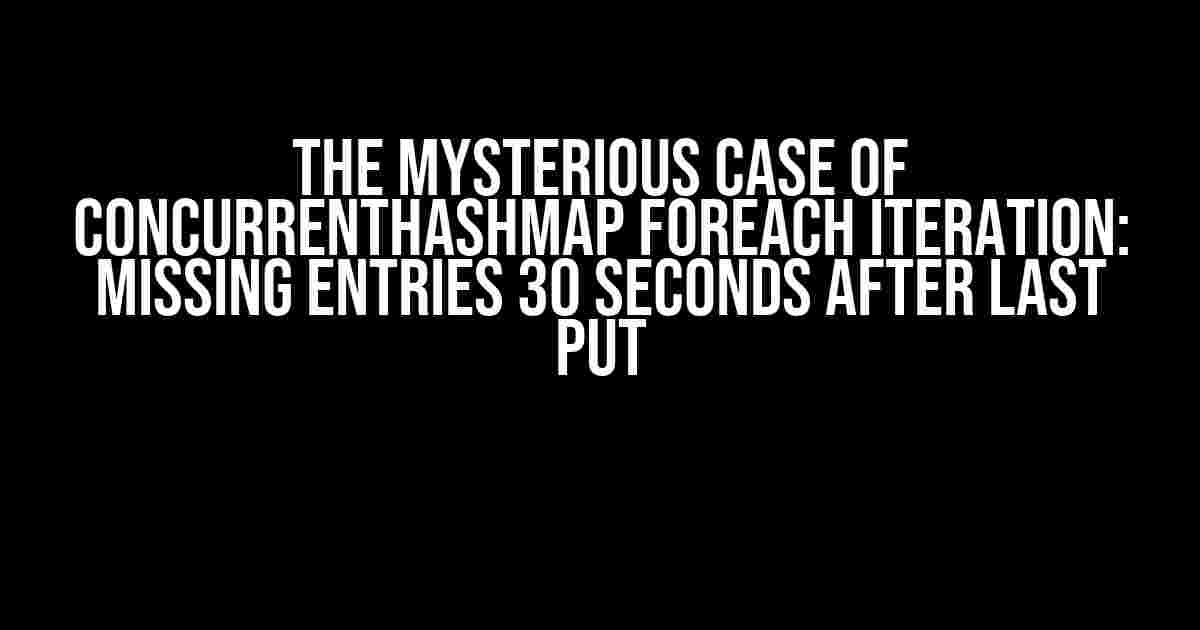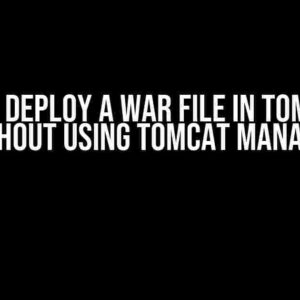Java developers, gather ’round! Have you ever encountered an issue where your ConcurrentHashMap’s forEach iteration suddenly stopped returning all entries, leaving you scratching your head in confusion? You’re not alone! In this article, we’ll delve into the mystifying phenomenon of ConcurrentHashMap’s forEach iteration missing entries 30 seconds after the last put, and provide you with the solutions to this enigmatic problem.
The ConcurrentHashMap Conundrum
The ConcurrentHashMap is an incredibly powerful and widely used data structure in Java, especially in distributed systems and multi-threaded applications. It’s designed to provide high concurrency, low contention, and excellent performance. However, this potency comes with a cost – complexity. As developers, we need to be aware of the intricacies of ConcurrentHashMap to avoid unexpected behavior, like the one we’re about to discuss.
Understanding ConcurrentHashMap’s Segments and Hash Buckets
To grasp the issue at hand, it’s essential to understand how ConcurrentHashMap stores its data. The map is divided into segments, each containing a hash table with a fixed number of buckets. These buckets are, in turn, comprised of a linked list of entries. When you put an entry into the map, it gets stored in one of these buckets based on the hash code of the key.
public ConcurrentHashMap<K, V>() {
this(16, 0.75f, 16);
}
public ConcurrentHashMap(int initialCapacity, float loadFactor, int concurrencyLevel) {
if (!(loadFactor > 0) || initialCapacity < 0 || concurrencyLevel <= 0)
throw new IllegalArgumentException();
this LoadFactor = loadFactor;
this segments = Segment.<K, V>newSegmentArray(initialCapacity);
this segmentShift = 32 - (concurrencyLevel - 1).leadingZeroes();
this.segmentMask = concurrencyLevel - 1;
}
Notice how the `concurrencyLevel` parameter determines the number of segments. This is crucial in our investigation, as it affects the iteration behavior.
The Problem: Missing Entries 30 Seconds After Last Put
Now that we've established a basic understanding of ConcurrentHashMap's internal workings, let's dive into the issue at hand. Consider the following scenario:
- You have a ConcurrentHashMap, and you've successfully put several entries into it.
- After 30 seconds of inactivity, you attempt to iterate over the map using the `forEach` method.
- To your surprise, some entries are missing from the iteration!
This phenomenon can be attributed to ConcurrentHashMap's built-in feature: segment garbage collection. When the map is idle for an extended period, the segments are subject to garbage collection, which can lead to the loss of entries.
Segment Garbage Collection: The Culprit Behind the Missing Entries
In ConcurrentHashMap, each segment has a `gc` (garbage collection) counter associated with it. When you put an entry, the segment's `gc` counter is incremented. If the counter reaches a certain threshold (determined by the `gcWindow` parameter), the segment becomes eligible for garbage collection.
private static final int GC_WINDOW = 16384;
private void writeObject(ObjectOutputStream s)
throws IOException {
s.defaultWriteObject();
s.writeInt(gcWindow);
// ...
}
private void readObject(ObjectInputStream s)
throws IOException, ClassNotFoundException {
s.defaultReadObject();
gcWindow = s.readInt();
// ...
}
After 30 seconds of inactivity, the `gc` counter is reset to 0, making the segment eligible for garbage collection. When you iterate over the map, the segments that have been garbage collected will not be included in the iteration, resulting in missing entries.
Solutions to the Mysterious Case
Now that we've identified the root cause of the issue, let's explore the solutions to this enigmatic problem:
Solution 1: Increase the `gcWindow` Parameter
One way to mitigate the issue is to increase the `gcWindow` parameter, effectively reducing the frequency of segment garbage collection. You can do this by creating a custom `ConcurrentHashMap` subclass and overriding the `gcWindow` parameter:
public class CustomConcurrentHashMap<K, V> extends ConcurrentHashMap<K, V> {
private static final int GC_WINDOW = 32768;
// ...
}
Solution 2: Use `lock Striping` Instead of `segment`
Another approach is to use lock striping instead of segments. Lock striping is a technique where a single lock is divided into multiple stripes, each protecting a portion of the data structure. This allows for more efficient concurrent access and reduces the likelihood of segment garbage collection.
public class CustomConcurrentHashMap<K, V> extends AbstractMap<K, V> {
private final Object[] lockStripes;
public CustomConcurrentHashMap(int numStripes) {
lockStripes = new Object[numStripes];
for (int i = 0; i < numStripes; i++)
lockStripes[i] = new Object();
}
// ...
}
Solution 3: Implement a Custom Iteration Mechanism
A more radical approach is to implement a custom iteration mechanism that iterates over the underlying segments, rather than relying on the `forEach` method. This allows you to control the iteration process and ensure that all entries are included:
public class CustomConcurrentHashMap<K, V> extends ConcurrentHashMap<K, V> {
@Override
public void forEach(BiConsumer<? super K, ? super V> action) {
for (Segment<K, V> segment : segments) {
for (HashEntry<K, V> entry = segment.first; entry != null; entry = entry.next) {
action.accept(entry.key, entry.value);
}
}
}
}
Conclusion
In conclusion, the ConcurrentHashMap's forEach iteration missing entries 30 seconds after the last put is a complex issue that requires a deep understanding of the data structure's internal workings. By recognizing the role of segment garbage collection and implementing one of the provided solutions, you can ensure that your ConcurrentHashMap iterations include all entries, even after extended periods of inactivity.
Remember, as Java developers, it's essential to be aware of the intricacies of the languages and libraries we use. By doing so, we can avoid unexpected behavior and create more robust, efficient, and scalable applications.
| Solution | Description |
|---|---|
| Increase `gcWindow` parameter | Reduce segment garbage collection frequency |
| Use lock striping instead of segments | Improve concurrent access and reduce segment garbage collection |
| Implement custom iteration mechanism | Control iteration process and ensure all entries are included |
Now, go forth and conquer the mystifying world of ConcurrentHashMap!
Frequently Asked Question
Get the answers to the most frequently asked questions about ConcurrentHashMap's mysteries!
Why does ConcurrentHashMap's forEach iteration miss some entries 30 seconds after the last put?
This phenomenon can occur due to the ConcurrentHashMap's segmented architecture. When you iterate over the map using forEach, it retrieves the data from the segments, but it doesn't guarantee to reflect the latest updates. The missing entries might be due to the iteration happening before the last put operation is propagated to all segments. It's essential to understand that ConcurrentHashMap prioritizes performance over consistency, especially during high-concurrency scenarios.
Is there a way to ensure that all entries are reflected during iteration?
One possible solution is to use a lock or synchronization mechanism to ensure that no updates occur during iteration. However, this approach may compromise the performance benefits of ConcurrentHashMap. Alternatively, you can consider using a CopyOnWriteArrayList or a synchronized block to create a snapshot of the map before iteration. This approach guarantees consistency but may incur additional memory and performance overhead.
How does ConcurrentHashMap's iteration mechanism work?
ConcurrentHashMap uses a mutable snapshot of the map, which is created when the iteration begins. This snapshot reflects the state of the map at that particular point in time. As the iteration progresses, any updates or modifications made to the map won't be reflected in the snapshot. This approach enables efficient iteration while minimizing the impact of concurrent updates.
Can I use ConcurrentHashMap in a scenario that requires strong consistency?
If strong consistency is a critical requirement, it's recommended to explore alternative data structures or synchronization mechanisms. ConcurrentHashMap is designed for high-concurrency scenarios where performance is paramount. If consistency is more important, consider using a synchronized map or a database that provides strong consistency guarantees.
Are there any other concurrency-related issues I should be aware of when using ConcurrentHashMap?
Another crucial aspect to consider is the potential for concurrent modification exceptions. When using ConcurrentHashMap, it's essential to handle these exceptions correctly, as they can occur when the map is modified during iteration. Additionally, be mindful of the impact of rehashing, which can occur when the map grows or shrinks, affecting performance and iteration.





